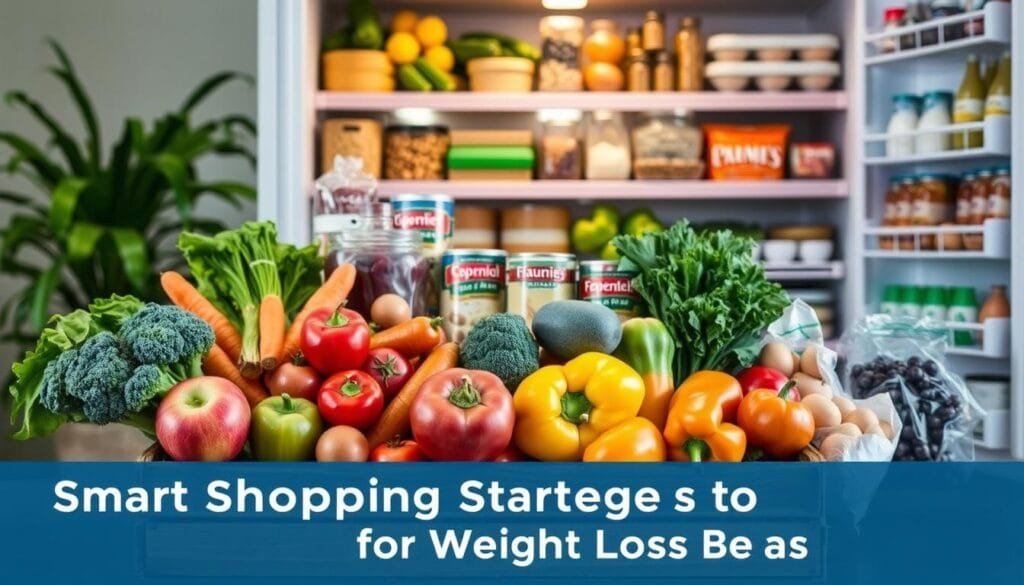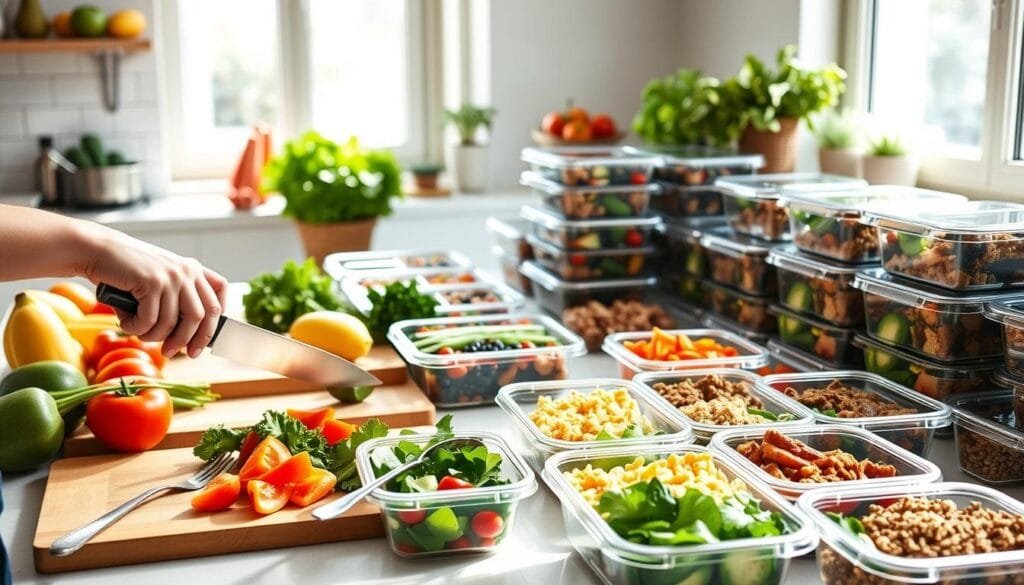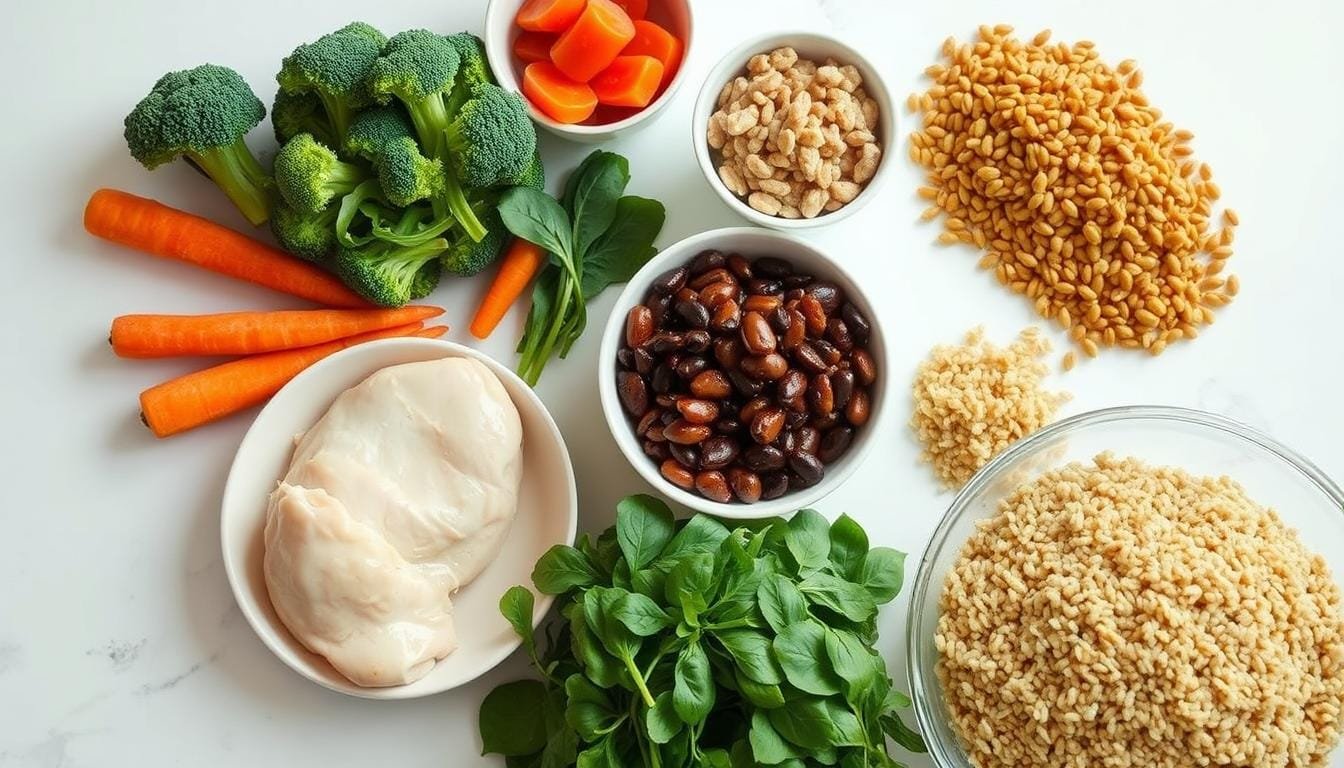I once stood in the grocery store with an empty cart and wallet. I thought healthy eating meant costly organic produce and superfoods. That day, I decided to challenge this idea.
My experience showed that a cheap diet meal plan to lose weight is possible. I found that budget weight loss strategies can be powerful. I created an affordable meal plan that helped me lose weight and save money.
This guide shares insights on cost-effective nutrition. You’ll find tips to make your weight loss journey successful and affordable. These work for students, busy parents, or anyone looking to slim down cheaply.
Key Takeaways
- Effective weight loss is possible on a budget
- Smart shopping and meal planning are crucial for affordable nutrition
- Seasonal produce and bulk buying can significantly reduce costs
- Protein-rich foods can be sourced economically
- Meal prep saves both time and money
- A structured meal plan aids in both weight loss and budget management
Understanding the Basics of Budget-Conscious Weight Loss
Shedding pounds doesn’t have to empty your wallet. Smart budget nutrition can help you lose weight effectively. Let’s explore how to slim down without overspending.
Nutritional Requirements for Sustainable Fat Loss
Focus on nutrient-dense, whole foods for budget-friendly weight loss. Forget pricey “superfoods” and stick to lean proteins, complex carbs, and healthy fats. Frozen veggies are cheap and just as nutritious as fresh ones.
Beans and lentils are affordable protein sources that keep you full. They’re excellent for maintaining a balanced diet on a budget.
The Connection Between Budget and Healthy Eating
Eating healthy can actually save you money. Home-cooked meals are cheaper than dining out or buying processed foods. Meal planning and bulk buying can reduce your grocery expenses.
A block of cheese costs less than pre-shredded varieties. Investing in healthy food now may prevent costly health issues later.
Calculating Your Daily Caloric Needs
Knowing your calorie needs is key to weight loss. Your needs depend on age, gender, height, weight, and activity level. Create a calorie deficit by eating less than you burn.
Aim for a 500-calorie daily deficit to lose about 1 pound per week. This is a safe, sustainable rate for most people.
| Activity Level | Calorie Multiplier |
|---|---|
| Sedentary | BMR x 1.2 |
| Lightly Active | BMR x 1.375 |
| Moderately Active | BMR x 1.55 |
| Very Active | BMR x 1.725 |
You’re now ready to start your budget-friendly weight loss journey. Small, consistent changes can lead to big results over time.
Smart Shopping Strategies for Weight Loss Success
Budget grocery shopping can support nutrition and weight loss goals. Seasonal produce and bulk buying create a cost-effective meal plan. These strategies help maintain a healthy diet without breaking the bank.
Seasonal Produce Shopping Guide
Buying in-season fruits and vegetables saves money and boosts nutrition. They’re cheaper and at peak flavor when in season.
Spring offers asparagus and strawberries. Summer brings tomatoes and cucumbers. Fall is great for pumpkins and apples. Winter provides kale and citrus fruits.

Bulk Buying Benefits and Tips
Bulk buying can save money on pantry staples like rice, beans, and nuts. Portion these items into smaller containers for proper storage.
Freeze perishables you can’t use right away. This cuts grocery bills while ensuring healthy options are always available.
Cost-Effective Protein Sources
Protein doesn’t have to be expensive. Canned tuna, eggs, and legumes are affordable and versatile options.
Use these in salads, sandwiches, and stir-fries. They keep you full and support muscle health without overspending.
| Protein Source | Price per Serving | Protein Content |
|---|---|---|
| Canned Tuna | $0.50 | 20g |
| Eggs | $0.25 | 6g |
| Lentils | $0.15 | 9g |
Smart shopping helps with weight loss and saves money. Make informed choices and plan ahead for success.
Cheap Diet Meal Plan to Lose Weight
This budget-friendly meal plan is nutritious and satisfying. It helps you lose weight without spending too much. Let’s explore tasty options that keep you healthy and save money.
Breakfast Options Under $2
Start your day with cheap, healthy meals. Overnight oats with frozen berries cost $1.50 per serving. They take only 5 minutes to prep.
For a protein-rich breakfast, try an egg and vegetable scramble at $1.80 per plate. These options give you essential nutrients for your morning.
Budget-Friendly Lunch Ideas
For lunch, consider mason jar salads or hearty vegetable soups. A tuna salad with whole grain crackers costs about $1.95. It offers 20 grams of protein.
These lunches are easy to make in bulk. You’ll save time and money throughout the week.
Affordable Dinner Recipes
Tasty dinners don’t have to be expensive. Grilled chicken with vegetables costs $2.50 per serving. For a vegetarian option, try lentil curry with rice at $1.80 per plate.
Low-Cost Healthy Snacks
Keep hunger away with budget-friendly snacks. Greek yogurt with fruit ($1.20) is a great option. Carrot sticks with hummus ($0.90) are also good.
These snacks are packed with nutrients. They won’t hurt your weight loss efforts.
| Meal | Cost | Protein (g) |
|---|---|---|
| Overnight Oats | $1.50 | 15 |
| Tuna Salad | $1.95 | 20 |
| Grilled Chicken | $2.50 | 25 |
| Greek Yogurt Snack | $1.20 | 12 |
This meal plan costs just over $5 per day. It gives you over 150 grams of protein and about 2,000 calories. Eating healthy on a budget is possible with planning and smart choices.
Meal Prep Techniques for Maximum Savings
Meal prep is a game-changer for budget planning and weight loss. I’ve lost 25 lbs in five years with meal prep. Here are some cooking tips that worked for me.
Efficient meal prep is key. I can prep a week’s meals in just one hour. This saves time and helps me stick to my goals.

My strategy creates balanced meals between 300-500 calories each. Here’s a typical breakdown:
- Breakfast: 300-400 calories
- Morning snack: 100 calories
- Lunch: 400 calories
- Afternoon snack: 200 calories
- Dinner: 400 calories
This totals around 1500 calories per day, ideal for weight loss. Eating 4-5 times daily helps manage hunger and energy levels.
Glass containers, mason jars, and a rice cooker make meal prep easier. These tools keep meals fresh all week. I use whole, minimally processed foods, especially fruits and veggies.
These tips have helped me save money and lose weight. Create a system that works for you long-term.
Essential Budget-Friendly Foods for Weight Loss
Losing weight can be affordable. Discover cheap protein sources, carbs, and healthy fats that help shed pounds. These options are nutritious and easy on your wallet.
Affordable Protein Sources
Protein aids weight loss without costing much. Eggs are versatile, providing about 6 grams of protein each. Canned tuna and sardines offer high-quality protein cheaply.
For plant-based options, try lentils and beans. They provide both protein and fiber at a low cost.
Low-Cost Complex Carbohydrates
Affordable carbs keep you full and energized. Brown rice costs pennies per serving. Oats are budget-friendly for breakfast or snacks.
Sweet potatoes offer complex carbs and vital nutrients at a reasonable price.
Check This:
- 10 Tips on How to Eat Out on a Keto Diet Without Breaking Your Progress
- Affordable Meal Planning: 7 Days of Cheap Meals for the Week
Inexpensive Healthy Fats
Fats are essential for hormone balance and feeling full. Seasonal avocados are a great source of healthy fats. Buying nuts in bulk saves money while providing omega-3s.
Olive oil lasts long and adds flavor to many dishes.
- Eggs: 6g protein per egg
- Lentils: 9g protein per 1/2 cup
- Brown rice: 5g protein per cup
- Avocado: 21g healthy fat per fruit
Use these foods to create nutritious, weight-loss-friendly meals without overspending. Smart shopping and meal planning help maintain a healthy diet on a budget.
Weekly Meal Planning on a Tight Budget
This practical weekly meal plan combines weight loss with budget-friendly options. You can eat nutritiously without spending too much money.
7-Day Sample Meal Plan
The meal plan averages 1460 calories daily. It has a balanced nutrient breakdown of 25% protein, 30% fat, and 40% carbs.
Each day’s meals offer variety and nutrition while keeping costs low.
| Day | Calories | Fat (g) | Carbs (g) | Protein (g) |
|---|---|---|---|---|
| 1 | 1400 | 40 | 160 | 110 |
| 2 | 1500 | 55 | 140 | 120 |
| 3 | 1450 | 45 | 160 | 110 |
| 4 | 1480 | 40 | 170 | 115 |
| 5 | 1520 | 50 | 150 | 125 |
| 6 | 1470 | 45 | 160 | 115 |
| 7 | 1460 | 45 | 150 | 120 |
Shopping List Template
A budget shopping list helps you stick to your meal plan. Affordable protein sources like canned beans are versatile and full of fiber.
Americans spend about 11.3% of their income on food. Smart shopping can save you a lot of money.
Cost Breakdown Analysis
The meal cost analysis shows an average of $3 per serving. Easy Chicken Fried Rice costs just $1.53 per serving.
The nutrient-dense Vegetarian Spaghetti Squash Lasagna is $2.91 per serving. This meal plan can help you save money compared to eating out.
Conclusion
A budget-friendly diet can lead to sustainable weight loss and better health. Plan meals, shop smart, and prep wisely to reach your goals affordably. The meal plans range from 1,200 to 2,000 calories for safe weight loss.
This approach is a long-term investment in your well-being. A 2024 study linked more fruits, veggies, and whole grains to lower belly fat. High-fiber foods like apples and legumes save money and boost health.
Start small by swapping one meal a week for a meatless option. Buy in bulk when there’s a sale to save more. Free shipping on orders over $75 awaits you.
New customers get a 10% discount to begin their health journey. Your wallet and waistline will soon show positive changes!
Source Links
- https://www.goodhousekeeping.com/health/diet-nutrition/g4351/1200-calorie-diet-plan/ – A Simple 7-Day, 1,200-Calorie Weight Loss Meal Plan
- https://www.eatingwell.com/category/4305/weight-loss-meal-plans/ – Weight-Loss Meal Plans

